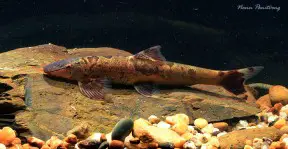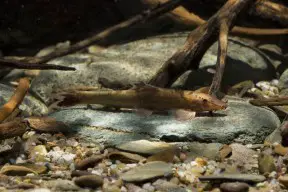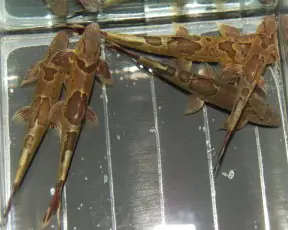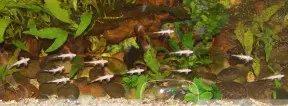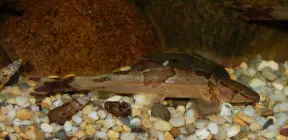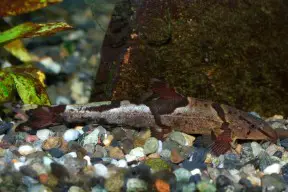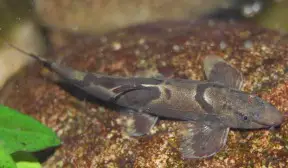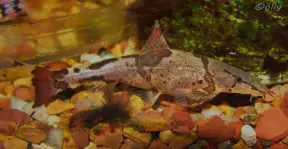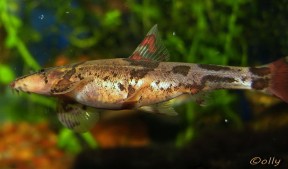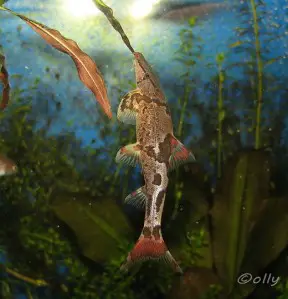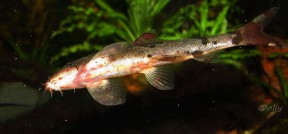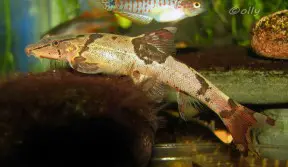Homaloptera confuzona
Etymology
Homaloptera: From the Greek homalos (= flat,level or even) and ptera (= wing), a reference to the horizontal positioning of the pectoral and ventral fins.
confuzona: A contraction of the Latin confusus, meaning confused, and zona, meaning belt, a reference to the four irregularly shaped and sometimes absent darker bars.
Classification
Order: Cypriniformes Family: Balitoridae
Distribution
Most records pertain to the Mekong River basin downstream of the Khone waterfalls in Laos and Cambodia, but this species is also known from some smaller river drainages in southern Thailand, including parts of the Mae Klong system.
Type locality is ‘Khlong Fit at Ban Kraduk Chang, road 3157 from Trat to borai, about 2-3 kilometers after junction with road 3271, 12°28’N, 102°38’E, Trat Province, Thailand’.
Habitat
An obligate dweller of swiftly-flowing streams and headwaters containing clear, oxygen-saturated water. It often inhabits riffles and runs and is likely to show a preference for shallower zones.
Substrates are generally composed of gravel, rocks, boulders or bedrock carpeted with a rich biofilm formed by algae and other micro-organisms. Patches of aquatic plants are only occasionally present but riparian vegetation is usually well-developed.
We’ve been unable to obtain details of sympatrically-occurring species but other fishes from the Mekong basin inhabiting similar environments include Acanthocobitis zonalternans, Annamia normani, Nemacheilus binotatus, N. pallidus, N. platiceps, Sewellia breviventralis, S. lineolata, S. speciosa, Lepidocephalichthys berdmorei, L. furcatus, L. hasselti, Crossocheilus atrilimes, C. reticulatus, plus various Barilius, Devario, ‘Puntius‘, Rasbora, Acanthopsoides, Balitora, Hemimyzon, Schistura, Akysis, Glyptothorax, Rhinogobius and other Homaloptera species.
Maximum Standard Length
75 – 85 mm.
Aquarium SizeTop ↑
An aquarium with base dimensions of 120 ∗ 30 cm or equivalent is required for long-term maintenance.
Maintenance
Most importantly the water must be clean and well-oxygenated so we suggest the use of an over-sized filter as a minimum requirement.
Turnover should ideally be 10-15 times per hour so additional powerheads, airstones, etc., should be employed as necessary to achieve the desired flow and oxygenation.
Base substrate can either be of gravel, sand or a mixture of both to which should be added a layer of water-worn rocks and pebbles of varying sizes.
Driftwood roots and branches are also suitable and although rarely a feature of the natural habitat aquatic plants from adaptable genera such as Microsorum, Crinum and Anubias spp. can also be added. The latter are particularly useful as Homaloptera spp. appear to enjoy resting on their leaves.
Since it needs stable water conditions and feeds on biofilm this species should never be added to a biologically immature set-up, and a tightly-fitting cover is necessary since it can literally climb glass. While regular partial water changes are essential aufwuchs can be allowed to grow on all surfaces except perhaps the viewing pane.
Water Conditions
Temperature: 20 – 25.5 °C
pH: 6.0 – 7.5
Hardness: 18 – 268 ppm
Diet
Homaloptera spp. are specialised grazers feeding on biofilm, small crustaceans, insect larvae and other invertebrates.
In captivity some sinking dried foods may be accepted but regular meals of live or frozen Daphnia, Artemia, bloodworm, etc., are essential for the maintenance of good health, and it’s highly preferable if the tank contains rock and other solid surfaces with growths of algae and other aufwuchs.
Balitorids are often seen on sale in an emaciated state which can be difficult to correct. A good dealer will have done something about this prior to sale but if you decide to take a chance with severely weakened specimens they’ll initially require a continual, easily-obtainable source of suitable foods in the absence of competitors if they’re to recover.
Behaviour and CompatibilityTop ↑
Not an aggressive fish although its particular requirements limit the choice of suitable tankmates.
Species inhabiting similar environments include Barilius, Discherodontus, Garra, Devario, some Rasbora, gobies of the genera Rhinogobius, Sicyopterus and Stiphodon plus Glyptothorax, Akysis and Oreoglanis spp. catfishes.
Many loaches from the family Nemacheilidae and most from Balitoridae are also suitable although harmless squabbles may occur with the latter group in particular. Research your choices before purchase to be sure.
It’s found living in aggregations in nature so buy six or more to see it at its best as when kept singly or in smaller groups it’s less bold.
The interaction between individuals is also interesting to watch and a group will typically arrange themselves close to one another facing directly into the water flow at certain times of day.
Sexual Dimorphism
Sexually mature females are usually a little larger and fuller-bodied than males.
Reproduction
Presumably a seasonal spawner in nature but nothing has been recorded in aquaria.
NotesTop ↑
This species is available in the aquarium trade from time-to-time though it’s not always identified correctly.
It can be told apart from congeners by the following unique combination of characters: body colour yellowish to reddish brown, with 4 irregularly-shaped or incomplete dark bars on body (sometimes absent); anterior body bar at level of pectoral-fin, narrow, usually reaching pectoral-fin; second bar at dorsal-fin origin, very broad dorsally, extending along base of whole fin, more or less triangular in shape, restricted to upper half of body or continuing to pelvic-fin origin via a thin extension; third bar above anal-fin base, very irregular, often restricted to upper half of body or missing entirely; fourth bar at base of caudal peduncle and continuous with a dark blotch on caudal-fin base and lower caudal-fin lobe; second and third bars often connected along the dorsal surface, first and second rarely so; presence of a conspicuous stripe from tip of snout through eye to nape and another extending from eye towards throat; colour pattern on fins less variable, 6-7 simple and 10-11 branched pectoral-fin rays; 2 simple and 7 branched pelvic-fin rays; 62-67 + 2 lateral line scales.
H. confuzona, H. orthogoniata and H. parclitella appear very similar at first glance but can be told apart by a few characters, the most useful of which to aquarists are the dark markings extending from the snout over the dorsal surface. These form a series of variable saddle-shaped blotches in all three species but there are some marked differences.
For example in H. orthogoniata and H. parclitella the ‘saddles’ are noticeably broader, more regularly-shaped and well-defined than in H. confuzona and usually extend into the lower half of the body.
Further, H. parclitella always has two saddles and H. orthogoniata three, whereas in H. confuzona there may be up to four irregularly shaped markings which are often restricted to the upper half of the body. One shared feature is an additional dark bar at the caudal peduncle.
Another feature shared by members of the H. ocellata group is keeled scales; for example in H. bilineata each scale has a single, wide keel orientated posteriorly. In H. confuzona the keels are rounded and in H. ogilviei elongate; in both cases they’re positioned at the posterior edge of the scale.
In H. orthogoniata, H. ocellata and H. parclitella a central, broad keel is flanked by two smaller ones. Other defining characters for H. parclitella include 5 branched anal-fin rays, 2 simple and 8-9 branched pelvic-fin rays, 5 simple and 12-13 branched pectoral–fin rays and 12-14 scale rows above the pelvic-fin origin.
The genus Homaloptera van Hasselt, 1823 has long been considered a polyphyletic assemblage (Kottelat, 1998), and following Randall & Page (2015) the majority of members have been moved into other genera as recognized therein:
Homalopteroides Fowler, 1905 with 11 species (Homalopteroides wassinkii, H. modestus, H. rupicola, H. smithi, H. stephensoni, H. weberi, H. tweediei , H. indochinensis, H. nebulosus, H. yuwonoi, and H. avii), is the most diverse and widely distributed genus of species formerly in Homaloptera. It is known from northeast India, Myanmar, Thailand, Laos, Cambodia, Vietnam (? see Kottelat 2012:51), Peninsular Malaysia, Sumatra, Java, and Borneo.
Homalopterula Fowler, 1940 is only known to occur in Sumatra and consists of six species, five described from Aceh Province (H. heterolepis, H. ripleyi, H. modiglianii, H. amphisquamata, and H. vanderbilti) andH. gymnogaster from Sumatera Barat province.
Balitoropsis Smith, 1945 contains two species, B. zollingeri and B. ophiolepis. The original type species B. bartschi (Smith, 1945) is now considered synonymous with B. zollingeri.
Pseudohomaloptera Silas, 1953, which has not been valid since 1953, now contains six species (P. tatereganii, P. sexmaculata, P. leonardi, P. yunnanensis, P. vulgaris, and P. batek) and is known to occur in southern China, Thailand, Laos, Cambodia, Peninsular Malaysia, and Borneo.
Ghatsa Randall & Page, 2015, contains the type species G. montana Herre, 1945, and four tentatively assigned species (G. pillaii, G. menoni, G. santhamparaiensis, and G. silasi).
Homaloptera van Hasselt, 1823, consists of six species (H. ocellata [type species], H. bilineata, H. orthogoniata, H. ogilviei, H. confuzona, and H. parclitella) found in Myanmar, Thailand, Cambodia, Peninsular Malaysia, Sumatra, Java, and Borneo.
Homaloptera is distinguished by the following combination of characters: reddish tints on fins in life; dorsal-fin origin anterior to pelvic-fin origin; 7–8½, 8½ (M) branched dorsal-fin rays; 7 branched pelvic-fin rays; forked caudal fin; keeled scales; 20–27 predorsal scales; 59–73 total lateral-line scales; no adipose keel on caudal peduncle; anus closer to anal-fin origin than to pelvic-fin insertion; large rostral cap; 2 thick rostral barbels in close proximity to each other; thick triangular upper lip; fleshy pad between lateral portions of lower lip; absence of central furrow at isthmus.
All Homaloptera spp. make fascinating aquarium inhabitants and are often referred to as ‘lizard’ loaches due to their behaviour and appearance. Like all balitorids they have morphology specialised for life in fast-flowing water, i.e., the paired fins are orientated and extended horizontally, head and body flattened, belly depressed.
These features form a powerful sucking cup which allows the fish to cling tightly to solid surfaces. The ability to swim in open water is greatly reduced and they instead appear to crawl and hop their way over rocks and other surfaces.
The family Balitoridae as recognised by Kottelat (2012) is widely-distributed across much of the Indian subcontinent, Southeast Asia and China.
References
- Kottelat, M., 2000 - Journal of South Asian Natural History 5(1): 37-82
Diagnoses of a new genus and 64 new species of fishes from Laos (Teleostei: Cyprinidae, Balitoridae, Bagridae, Syngnathidae, Chaudhuriidae and Tetraodontidae). - Alfred, E. R., 1967 - Copeia 1967(3): 587-591
Homaloptera ogilviei, a new species of homalopterid fish from Malaya. - Beamish, F. W. H., P. Sa-ardrit and V. Cheevaporn, 2008 - Journal of Fish Biology 72(10): 2467–2484
Habitat and abundance of Balitoridae in small rivers of central Thailand. - Blyth, E., 1860 - Journal and Proceedings of the Asiatic Society of Bengal 29(2): 138-174
Report on some fishes received chiefly from the Sitang River and its tributary streams, Tenasserim Provinces. - Kottelat, M., 1998 - Ichthyological Exploration of Freshwaters 9(3): 267-272
Homaloptera yuwonoi, a new species of hillstream loach from Borneo, with a new generic name for H. thamicola (Teleostei: Balitoridae). - Kottelat, M., 2012 - Raffles Bulletin of Zoology Supplement 26: 1-199
Conspectus cobitidum: an inventory of the loaches of the world (Teleostei: Cypriniformes: Cobitoidei). - Kottelat, M., 2013 - Raffles Bulletin of Zoology Supplement 27: 1-663
The fishes of the inland waters of southeast Asia: a catalogue and core bibliography of the fishes known to occur in freshwaters, mangroves and estuaries. - Randall, Z. S. and L. M. Page, 2012 - Zootaxa 3586: 329-346
Resurrection of the genus Homalopteroides (Teleostei: Balitoridae) with a redescription of H. modestus (Vinciguerra 1890). - Randall, Z. S. and L. M. Page, 2015 - Zootaxa 3926(1): 57-86
On the paraphyly of Homaloptera (Teleostei: Balitoridae) and description of a new genus of hillstream loaches from the Western Ghats of India. - Roberts, T. R., 1989 - Memoirs of the California Academy of Sciences 14: 1-210
The freshwater fishes of Western Borneo (Kalimantan Barat, Indonesia). - Roberts, T. R., 1993 - Zoologische Verhandelingen (Leiden) 285(1): 1-94
The freshwater fishes of Java, as observed by Kuhl and van Hasselt in 1820-23. - Tan, H. H. and M. Kottelat, 2009 - Ichthyological Exploration of Freshwaters 20(1): 13-69
The fishes of the Batang Hari drainage, Sumatra, with description of six new species. - Tan, H. H. and P. K. L. Ng, 2005 - Ichthyological Exploration of Freshwaters 16(1): 1-12
Homaloptera parclitella, a new species of torrent loach from the Malay Peninsula, with redescription of H. orthogoniata (Teleostei: Balitoridae). - Tang, Q., H. Liu, R. Mayden and B. Xiong, 2006 - Molecular Phylogenetics and Evolution 39(2): 347-357
Comparison of evolutionary rates in the mitochondrial DNA cytochrome b gene and control region and their implications for phylogeny of the Cobitoidea (Teleostei: Cypriniformes). - Šlechtová, V., J. Bohlen and H. H. Tan, 2007 - Molecular Phylogenetics and Evolution 44(3): 1358-1365
Families of Cobitoidea (Teleostei; Cypriniformes) as revealed from nuclear genetic data and the position of the mysterious genera Barbucca, Psilorhynchus, Serpenticobitis and Vaillantella.
